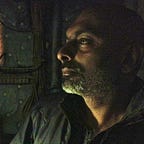I see you
A view from lockdown
The notion of connecting to an inner self through the eyes is familiar to us thanks to those much-quoted words: the eyes are windows to the soul — a strangely difficult quotation to attribute. On first meeting we place a lot of weight on another’s ability to look us in the eye and negatively judge those who do not. We seem just not to trust someone who cannot hold our gaze, it’s as if they are concealing something.
The alternative therapy Iridology claims the eyes are windows onto health. It links a patient’s past, present and future health, their issues and vulnerabilities to observed features in the eye. In terms of our psychological health, the loving look between mother and child is known to facilitate strong attachment and later support the development of the social brain. Our eyes, even more than our fingerprints, are our most unique feature: ocular recognition uses retinal and iris scanning to identify us — a technology now incorporated into some smartphones.
Then there are all those cultural and romantic references: the eyes across a crowded room that cause a flood of physiological responses; the poems, songs, and singers too, famed for their charm and coveted blue eyes. In the 18th century, the then Prince of Wales George IV inadvertently started a trend for tiny and beautifully painted eyes incorporated into jewellery. He commissioned a piece for his forbidden love Maria Fitzherbert as a discreet love token. When this was discovered his intimate gesture caught on, leading to a rash of miniature eye paintings on rings, lockets, snuff boxes, pendants and jewel-encrusted brooches — some depicting a single tear, all expressions of love.
Deeper still is the power of holding someone’s gaze in person, a mark of deep acceptance beyond words, a reinforcing of connection. The intensity and vulnerability it brings makes it feel risky to really look, and even scarier to really be seen.
I see you, is an online participatory artwork that draws on our preoccupation and fascination with the eye and the power of the gaze. It is an intimate portrait of people in- and emerging from lockdown, when we live with both the tragic and the banal, and can only wonder at the future. I see you invites you, for a moment, to appreciate what we see in others, in ourselves and in familiar surroundings — the beauty in these and their ability to see us through the difficult times.
We invite you to take a look and contribute your own eye.
